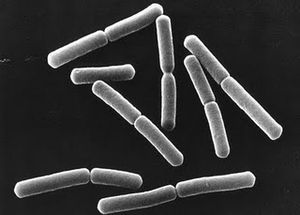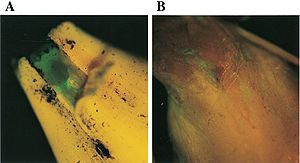Pseudomonas chlororaphis
THIS PAGE IS UNDER CONSTRUCTION
Thank you for your patience
Classification
Kingdom: Bacteria
Phylum: Proteobacteria
Class: Gamma Proteobacteria
Order: Pseudomonadales
Family: Pseudomonadaceae
Species
Pseudomonas chloroaphis
Sub Groups: aurantiaca, aureofaciens, chlororaphis, fragi, lundensis, taetrolens
Description and Significance
In Greek, Pseudomonad literally means 'false unit', being derived from pseudo and monas (Applied, 2002). The term "monad" was used in the early history of microbiology to denote single-celled organisms (Applied, 2002).
Common characteristics of Pseudomonas chlororaphis are rod-shaped, aerobic, gram-negative, one or more polar flagella, and non-spore forming (Todar, 2006)
Another characteristic includes secretion of pyoverdin, or fluorescent (Tombolini, 1999). This fluorescent is generally a yellow-green pigment and comes out when the organism is attached to the desired plant species, within the hystol section of soil, under iron limiting conditions (Meyer, 2002). Emission of these pigments allow for easy detection using siderophore typing (Meyer, 2002).
In addition, Pseudomonas chlororaphis is an effective biocontrol agent against Pythium aphanidermatum, a casual damping affect of hot pepper seedlings in greenhouse vegetable production, and this microorganism reduces and often eliminates soft-rot in leaves of the tobacco plant that is caused by Erwinia carotovora (European, 2009).
Many applications of Pseudomonas chlororaphis are in agriculture and horticulture by acting against various fungal plant pathogens by creating phenazine (antibiotic to root rot of cucumbers, peppers, tomatoes, and many other agricultural crops) (Woeng, 2000).
Genome Structure
The genome of Pseudomonas chlororaphis has not been mapped at this current time.
Cell Structure, Metabolism and Life Cycle
Pseudomonas chlororaphis are rod-shaped, gram-negative bacteria with one or more polar flagella and non-spore forming (Todar, 2006)
"Km-values for oxygen uptake were 1.4-5.6 micromolar. P. chlororaphis compete with Nitrosomonas europaea for oxygen in the rhizosphere, and this competition is determined by the oxidation kinetics of the electron donor (not the oxygen uptake kinetics of the organisms." (Bodelier and Laanbroek, 1997)
As described above, some strains of P. chlororaphis act as effective fungicides when found in situ, and when used in soil inoculation. The organisms shield plant roots by producing antibiotics and by immobilizing iron that is needed for fungal growth (EPA, 2009). P. chlororaphis also produces cytokinin and other plant growth factors that help plants resist fungal infection (EPA, 2009)
Ecology and Pathogenesis
Habitat; symbiosis; biogeochemical significance; contributions to environment.
If relevant, how does this organism cause disease? Human, animal, plant hosts? Virulence factors, as well as patient symptoms.
"The bacterium has shown no toxicity or pathogenicity to humans, wildlife, or the environment. It targets certain fungi that attack plant roots and cause wilt diseases, as well as stem and root rots. The pesticide product is applied by drenching the soil of contained plants. Because no harmful effects were seen in toxicity and pathogenicity studies, no adverse effects to humans are expected from use of pesticide products containing this bacterium." (EPA 2009, http://www.epa.gov/oppbppd1/biopesticides/ingredients/factsheets/factsheet_006478.htm)
microbewiki.kenyon.edu/index.php/pseudomonas Ecology Found in soil, water, plant tissue and animal tissue.
Krieg, Noel (1984). Bergey's Manual of Systematic Bacteriology, Volume 1. Baltimore: Williams & Wilkins. ISBN 0683041088
"Pseudomonas chlororaphis strain 63-28 is a naturally occurring bacterium that can be used in controlling various fungi that attack crop roots. Its use is limited to vegetables and ornamental crops in containers in greenhouses. The product AtEzeTM, the first pesticide product containing this active ingredient, was registered in September 2001 for a period of 18 months. During that period, the registrant is required to submit additional data, which will allow EPA to decide whether to grant the product a full registration." (EPA, 2009)
http://www.efsa.europa.eu/it/scdocs/doc/1431.pdf effective biocontrol agent against Pythium aphanidermatum, the causal agent of damping-off of hot pepper in greenhouse vegetable production systems. Root colonisation by a plant-beneficial rhizobacterium. Pseudomonas chloroaphis O6, induces disease resistance in tobacco against leaf pathogens Erwinia carotovora causing soft-rot and Pseudomonas syringae pv. tabaci causing wildfire. It was reported to produce an antifungal metabolite which is a crucial trait in its competition with the pytopathogenic fungus Fusarium oxysporum in the rhizosphere. Specifically, P. chlororaphis was described to control tomato foot and root rot caused by Fusarium oxysporum by root colonisation.
Shown to increase the yield of spring wheat when soils are inoculated. (Crop et al, 1996
Utilized in industrial production of acrylamide. (Yamada and Kobayashi, 1996; Asano et al, 1981)
http://www.efsa.europa.eu/it/scdocs/doc/1431.pdf A Pseudomonas chlororaphis isolate, obtained from perch intestine, was evaluated with regards to its potential to control Aeromonas sobria disease in farmed perch. An infection of perch with labelled P.chlororaphis indicated the bacterium is able to transiently colonise juvenile fish and fingerlings and to reduce A. sobria associated mortalities
Used as a soil inoculant in agriculture and horticulture by acting aginast certain fungal plant pathogens via production of phenazine type antibotics. (Chin-A-Woeng TF, et al. (2000). "Root colonization by phenazine-1-carboxamide-producing bacterium Pseudomonas chlororaphis PCL1391 is essential for biocontrol of tomato foot and root rot.". Mol Plant Microbe Interact 13 (12): 1340–5. doi:10.1094/MPMI.2000.13.12.1340. PMID 11106026.)
has shown no toxicity or pathogenicity to humans
European Food Safety Authority. Scientific Opinion on the maintenance of the list of QPS microorganisms intentionally added to food or feed. EFSA Journal 2009, 7(12): 1431.
http://www.efsa.europa.eu/it/scdocs/doc/1431.pdf
has shown no toxicity or pathogenicity to humans, wildlife,
Pseudomonas clororaphis is further described in the literature for its potential to produce secondary metabolites. For example, a strain of the nonpathogenic bacterial species P. chlororaphis was reported to be capable of producing rhamnolipids (Gunther et al., 2005). P. chlororaphis produces several secondary metabolites, in particular phenazine compounds, which contribute to some of its biocontrol activity (Anonymous, 2002; van Rij et al., 2004). Phenazine compounds, from other sources than P. chlororaphis, were reported to have some toxic effects on animal and human cells (Gamage et al., 2002; Allen et al., 2005; Lavaggi et al., 2008)
potentially toxic secondary metabolites.
References
http://aem.asm.org/cgi/reprint/65/8/3674
Meyer JM, and Geoffroy VA. (2002). Applied Environmental Microbiology 68 (6): 2745–53.
Chin-A-Woeng Tf. Mol Plant Microbe Interact 13. 2002. 12: 1340–5.
Tombolini Riccardo, Gaag Dirk Jan Gerhardson, Berndt and Jansson Janet. Colonization Pattern of the Biocontrol Strain Pseudomonas chlororaphis MA 342 on Barley Seeds Visualized by Using Green Fluorescent Protein. Applied and Environmental Microbiology. Aug. 1999. 3674-3680.
European Food Safety Authority. Scientific Opinion on the maintenance of the list of QPS microorganisms intentionally added to food or feed. EFSA Journal 2009, 7(12): 1431.
Todar, Kenneth. Pseudomonas. 16 Aug. 2006. http://microbewiki.kenyon.edu/index.php/Pseudomonas accessed 19 Apr. 2010
Author
Page authored by Brad J. Wardynski, Michael Wandersee, and Erika White, students of Prof. Jay Lennon at Michigan State University.


